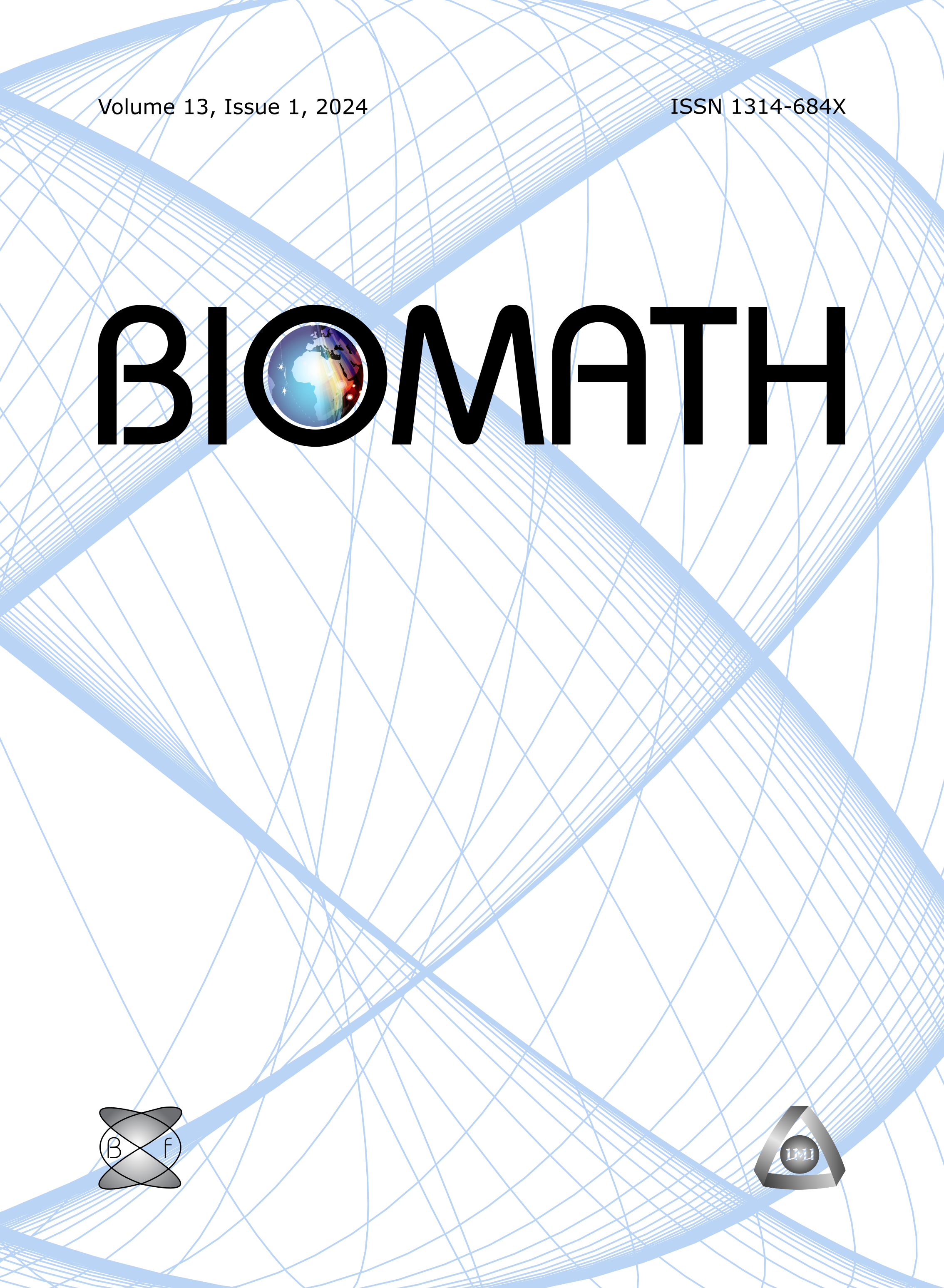Modelling the impacts of lockdown and isolation on the eradication of COVID-19
DOI:
https://doi.org/10.11145/j.biomath.2020.09.107Keywords:
COVID-19, isolation, lockdown, disease-free equilibrium, endemic equilibrium.Abstract
A model describing the dynamics of COVID-19 is formulated and examined. The model is meant to address the impacts of lockdown and social isolation as strategies for the eradication of the pandemic. Local stability analysis indicate that the equilibria are locally-asymptotically stable for R0<1 and R_0>1 for the disease-free equilibrium and the endemic equilibrium respectively. Numerical simulations of the model equations show that lockdown is a more effective strategy in the eradication of the disease than social isolation. However, strict enforcement of both strategies is the most effective means that could end the disease within a shorter period of time.References
WHO (2020). Coronavirus Disease 2019 (COVID-19) Situation Report-59, 19 March, 2020.
M. Peirlinck, K. Linka, F.S. Costabal and E. Kuhl (2020). Outbreak dynamics of COVID-19 in China and the United States, Biomechanics and Modelling in Michanobiology. https://doi.org/10.1007/s10237-020-01332-5.
M. Gotta, E. Bertuzzo, et al (2020). Spread and dynamics of the COVID-19 epidemic in Italy: Effects of emergency containment measures, Proceedings of the National Academy of Science. www.pnas.org/cgi/doi.10.1073/pnas.2004978117.
O.A. Adegboye, A.I. Adekunle and E. Gayawan (2020). Early transmission dynamics of novel coronavirus (COVID-19) in Nigeria, International Journal of Environmental Research and Public Health, 17 (2020) 3054.
doi: 10.3390/ijerph17093054
I. Frost, G. Osena, J. Craig, S. Hauck, E. Kalanxhi, O. Gatalo, Y. Yang, K. Tseng, E. Schueller, E. Klein and G. Lin (2020). COVID-19 in West Africa: National projections of exposed, contagious, symptomatic & severe cases, Publication of the Center for Disease Dynamics, Economics and Policy.
M. Mandal, S. Jana, S.K. Nandi, A. Khatua, S. Adak and T.K. Kar (2020). A model based on the dynamics of COVID-19: Prediction and control, Chaos, Solitons and Fractals, 135 (2020) 109889.
C.N. Ngonghala, E. Iboi, S. Eikenberry, M. Scotch, C.R. MacIntyre, M.H. Bonds and A.B. Gumel (2020). Mathematical assessment of the impact of non-pharmaceutical interventions on curtailing the 2019 novel Coronavirus, Mathematical Biosciences, 325 (2020) 108364.
https://doi.org/10.1016/j.mbs.2020.108364
Nigerian Centre for Disease Control (NCDC)(2020). COVID-19 Situation Report 79, March 18, 2020.
K. Mizumoto, K. Kagaya, A. Zarebski and G. Chowell (2020). Estimating the asymptomatic proportion of coronavirus disease 2019 (COVID-19) cases on board the Diamond Princess cruise ship, Yokohama, Japan, 2020, Euro Surveillance 2020, 25 (10). https://doi.org/10.2807/1560-7917
R. Anguelov, J. Banasiak, C. Bright, J. Lubuma and R. Ouifki (2020). The big unknown: The asymptomatic spread of COVID-19, Biomath 9 (2020), 2005103.
http://dx.doi.org/10.1145/j.biomath.2020.05.103
J. Jiao, Z. Liu and S. Cai (2020). Dynamics of an SEIR model with infectivity in incubation period and homestead-isolation on the susceptible, Applied Mathematics Letters, 107 (2020) 106442.
https://doi.org/10.1016/j.aml.2020106442
T. Xu, C. Chen, Z. Zhu, M. Cui, C. Chen, H. Dai and Y. Xue (2020). Clinical features and dynamics of viral load in imported and non-imported patients with COVID-19, International Journal of Infectious Diseases, 94 (2020), 68-71. https://doi.org/10.1016/j.ijid.2020.03.022
Downloads
Published
Issue
Section
License
The journal Biomath is an open access journal. All published articles are immeditely available online and the respective DOI link activated. All articles can be access for free and no reader registration of any sort is required. No fees are charged to authors for article submission or processing. Online publications are funded through volunteer work, donations and grants.
Authors who publish with this journal agree to the following terms:
- Authors retain copyright and grant the journal right of first publication with the work simultaneously licensed under a Creative Commons Attribution License 4.0 that allows others to share the work with an acknowledgement of the work's authorship and initial publication in this journal.
- Authors are able to enter into separate, additional contractual arrangements for the non-exclusive distribution of the journal's published version of the work (e.g., post it to an institutional repository or publish it in a book), with an acknowledgement of its initial publication in this journal.
- Authors are permitted and encouraged to post their work online (e.g., in institutional repositories or on their website) prior to and during the submission process, as it can lead to productive exchanges, as well as earlier and greater citation of published work (See The Effect of Open Access).

